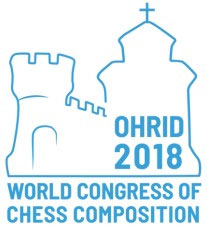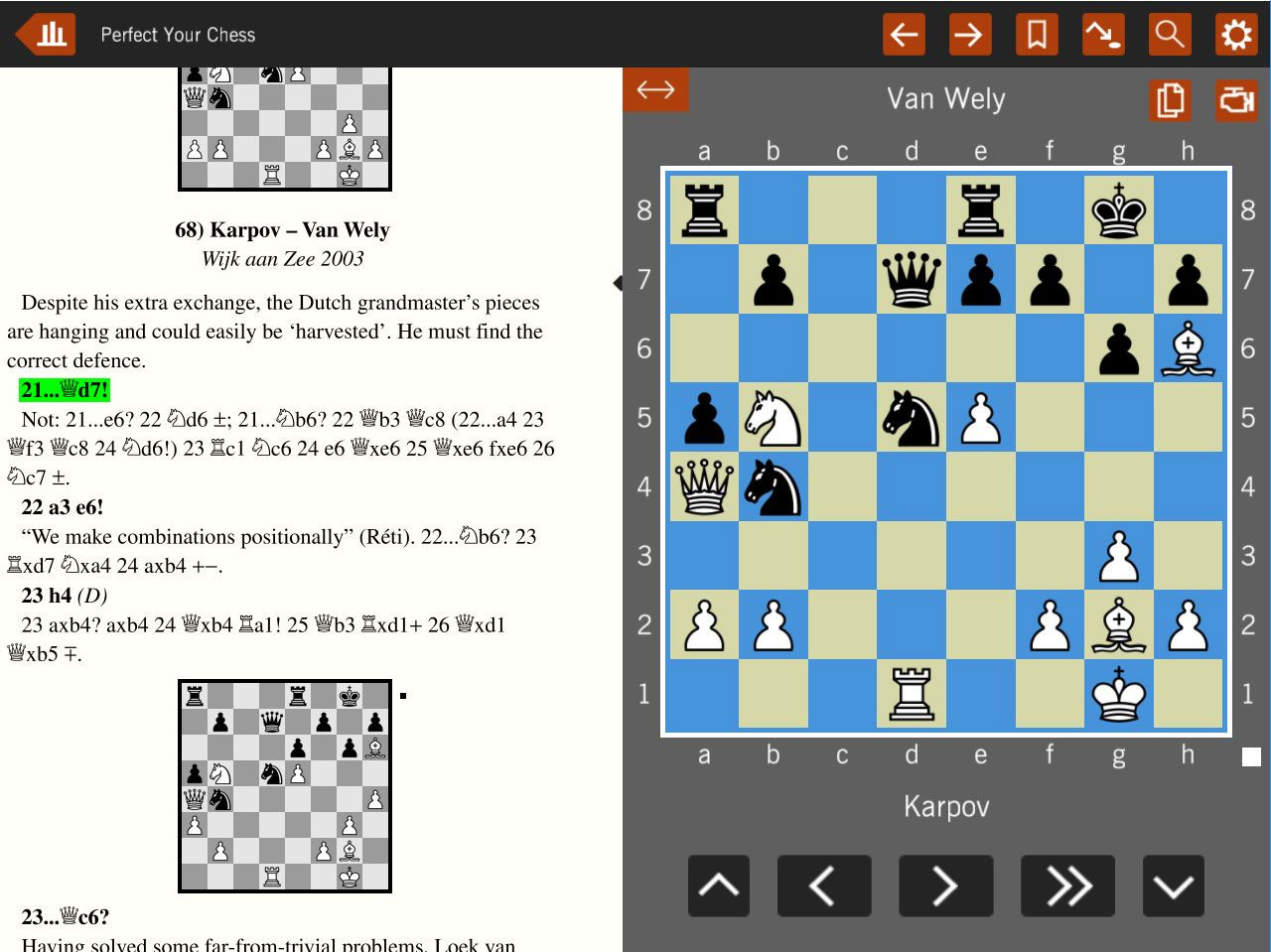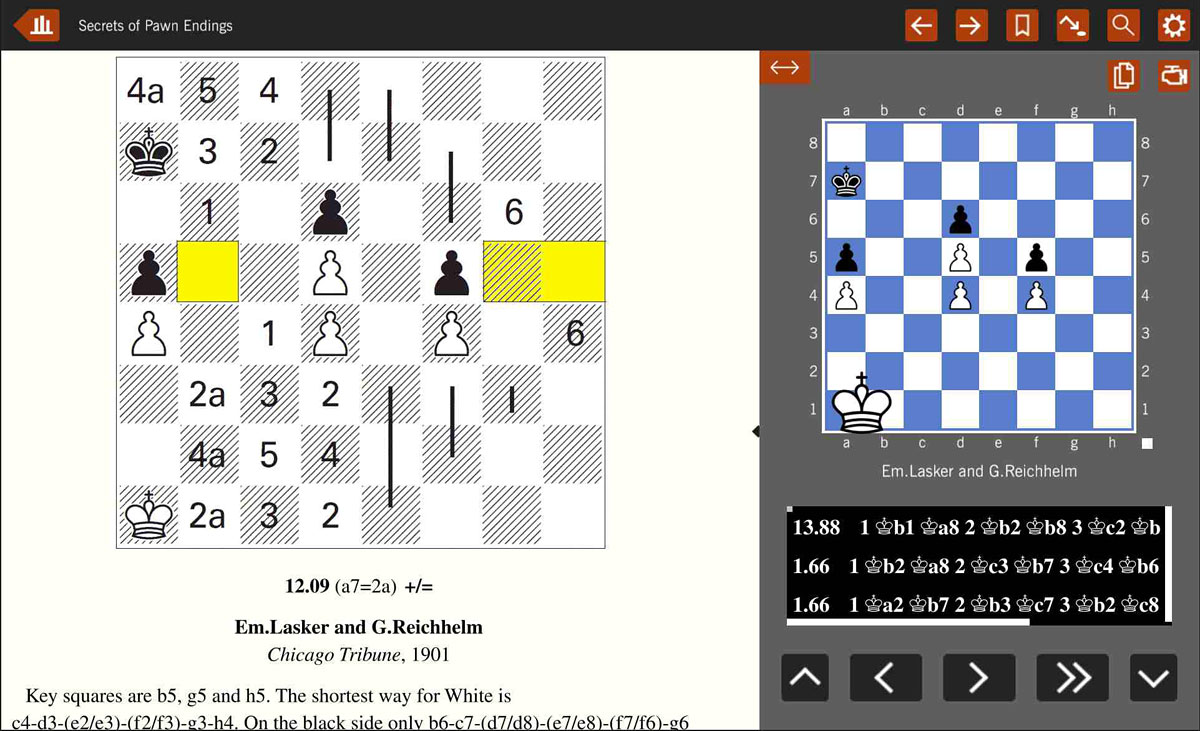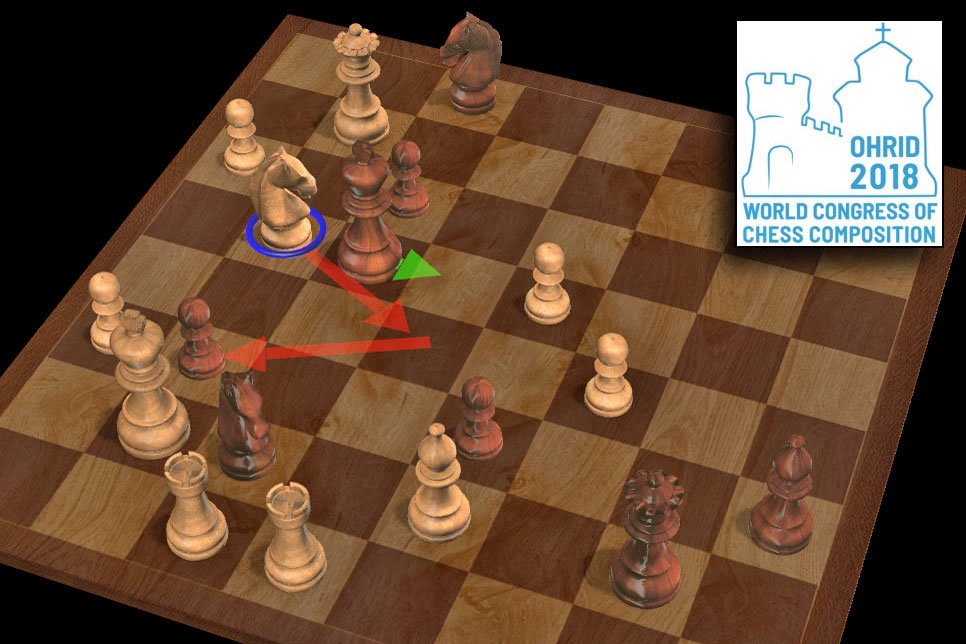42nd World Chess Solving Championship

This championship took place during the first week in September in the ancient town of Ohrid, in the south-west of Macedonia.* It lies on the shores of Lake Ohrid, a large lake which separates Macedonia from Albania.
The British team consisted of myself, Jonathan Mestel and David Hodge. The day before the World Championship starts, there is always an Open Championship, which I won with 46.5 points out of 60. In the team championships, we were third.
In my previous article, I selected six problems from the World Championship for readers to solve. Today I will present the annotated solutions, but before I show you the exact lines that solve the problems I would like to give you some help in working things out yourself. At the bottom of the page, you will find the full, replayable solutions.
We start with an attractive problem which defeated many top solvers.
Give yourself 25 minutes if you would like to simulate tournament conditions.
It often helps to start the solving process by deciding whether the first move (the key) will create a threat or put Black in zugzwang since the solving process is fundamentally different in the two cases. Here the limited number of Black moves suggests that zugzwang might be a possibility; for example, if the knight moves there is an immediate mate by Rb4#. The f8-bishop can only move to e7, otherwise Nd6 is mate, but ...Be7 can be met by fxe7 and mate follows.
As 1...Bb1 allows 2.b3#, that only leaves three Black moves, 1...f4, 1...a5 and 1...Bb3. A quick check shows that 1...a5 allows 2.b3+ Bxb3 3.Nb4+ Kxc5 4.Rb5#, but the other two moves do not allow a mate by move four. So the function of the key is likely to be the provision of mates after 1...f4 and 1.. .Bb3. The latter is the easier to deal with. By blocking b3, this move prevents the king from escaping to that square after 2.Nb4+, so 1...Bb3 2 Nb4+ Kc5 3 Nxa6+ Kc6 would lead to mate on the long diagonal if only the f1-bishop could move there.
This suggests the key will be 1.g3, 1.g4 or 1.Be2, all of which allow the bishop to deliver mate at the end of this line, but which one is it? This can only be determined by the need to provide a mate after 1...f4, and this is the trickiest part of the problem. The key weakness of 1...f4 is that it allows the white king to occupy e4, and after 2.Ke4 White can mate if he can transfer his bishop to e6 or f7 in two moves. Black is so tied up that it is hard for him to stop this manoeuvre, but it turns out that 1.Be2? f4 2.Ke4 f3 delays mate until move 5, while 1.g4? f4 2.Ke4 doesn’t threaten Bh3, because the pawn on g4 blocks the route to e6.
The first day of the two-day World Championship proper, which is for both individuals and teams, always consists of mates in 2, mates in 3 and endgame studies. The following three are chosen from the first day’s problems.
Time allowed: 7 minutes
Mates in two can be tricky because of the limited time available for solving (three problems in 20 minutes) and because the composer may incorporate tempting near-misses which fail only to a unique refutation, called tries. Here it’s fairly clear that White will have to move the knight on b5, as there’s almost no other way to create a threat, but where should the knight move?
To find out, it’s necessary to look at how Black might counter the threat of 2.Qb4#. One obvious method is to simply cover b4 by 1...Qe4, so White has to have a counter to this ready. This suggests either 1.Nc3 or 1.Nd6, so as to simply take on e4. However, 1.Nd6? fails to 1...Nb6 and White no longer has 2.Qe7# because his own knight is in the way.
1.Nc3? is even more tempting, and indeed I wrote this move down before crossing it out. It doesn’t threaten 2.Qb4# because it unpins Black’s knight, but it threatens 2.Na4# instead. However, this move is refuted by the brutal 1...Qxe2. The answer is to make a different knight move (see solution below).
Time allowed: 20 minutes
With so many pieces attacking Black’s king, and with Black’s men shut up in the top right corner, it’s surprising that there are any problems mating in three, but in fact, there’s only one way to do it. If you can’t make progress any other way, then it is sometimes worth trying to mate in two instead, and finding out why such attempts don’t work.
At the moment Black’s king can apparently escape to d5, so 1.Ne7? looks like an obvious attempt, intending 2.Bf5#, but after 1...f5 there is no mate in two. If the white king were not on g2 then he could continue Bg2#, exploiting the block on f5, so it’s worth thinking about a king move, so as to threaten 2 Ne7. The fact that the pawn has been placed on d7 is further evidence that Ne7 might be the threat, since otherwise ...Re8 would stop it.
But doesn’t White have to worry about 1...Kd5, running towards the queenside? It turns out not, because 1...Kd5 already has a mate prepared by 2.Ne3+ with the lines 2...Kc6 3.b5# and 2...Ke4 3.Bf5#. A king move is becoming increasingly plausible, but where should the king move? A dark square looks bad because Black can play 1.Kg1/f2? Bd4+ or 1.Kh2? Be5, so that leaves 1.Kh1 or 1 Kf1. Certainly, 1.Kf1 looks more likely and finding the line 1.Kf1 Be5 2.Qg2+ Kd3 3.Qe2# shows that the king needs to cover e2. Then it’s only a question of taking care to write down all the variations correctly.
Original problem, not yet published. Time allowed: 35 minutes.
This study should appeal to over-the-board players with its single forcing main line. The vast majority of solvers in the World Championship had no trouble with it, indeed the only difficulty is finding the first move. The full annotated solution is given in the replay board below.
On the second day, where things are generally decided, the problems tend to be more difficult and the time limited. I had a disastrous helpmate round, in particular failing to solve the following problem. Note that in a helpmate, both sides are cooperating to help White mate Black (although the moves still have to be legal). Black moves first, with White mating Black on his third move, so the sequence of moves goes B W B W B W mates. There are three such sequences and to get full marks you need to find all three.
Time allowed: 20 minutes
This problem is where any prospect of my winning the world championship came to an end. It’s really not very difficult, but I totally failed to see the idea. The g1-knight is rather far from the enemy king, so if it is going to play a part in a mate, then either the king has to move towards the knight or the other way around. The cluster of pawns e5-f5-f4 suggests that they might be there to take squares away from the black king, which in turn hints that there might be a mate with the king on e4.
Using these ideas, I found the solution 1...Qe3 2.Nh3 Kd4 3.b3+ Kxe4 4.Ng5# (although the move is numbered 4, it’s White’s third move). But then I got stuck, I couldn’t see any way the b2-pawn could play a part in another mate and I had no idea what the a5-pawn was for. The upshot was that I didn’t realise that all three solutions end with the black king being mated on e4, and the solutions all start with a black piece moving to e3.
Here’s a neat problem from the selfmate round.
In a selfmate, White is trying to commit suicide by forcing Black to mate him. Black is doing his best to avoid mating White. White plays first, and must force Black to give mate on his third move (at the latest).
It’s fairly clear that the only hope of mating the white king is by discovery along the long diagonal, and in addition to forcing the c6-knight to move, White must make sure either that Black delivers double check with the knight, or that no white pieces can interpose on the diagonal. In a selfmate in three, the threat often has no real connection to the main point of the problem, and Black’s defences prevent the threat almost by accident. Once you have found the key and the threat the rest generally falls into place quite quickly, but this crucial step can be quite awkward.
Forcing a double check by ...Nd4 or ...Ne5 is the simplest idea, but White also has to take into account that Black’s king can move to d7. The sequence 1 Nd4+ Kd7 2 Ne5+ stands out, and this would force Black to mate by ...Nxe5, except that it’s not mate because the white king can move to e2. But this is likely to arise as a variation if Black’s first move covers e2.
Despite this, e5 seems a likely square for the threat. I tried a couple more ideas involving Ne5+ but then realised that 1.Bb2 creates a threat of 2.Qf7+ Kd6 3.Be5+ Nxe5# and I felt it had to be the right idea, because it’s actually rather hard for Black to prevent this. There are only three defences, and two of these demonstrate the main point of the problem.
The solutions
*Editor's note: We use the name "Macedonia" as a shorthand, but recognize the official international name remains (for now) "Former Yugoslav Republic of Macedonia (FYROM)" unless/until the recent June agreement to change it officially to "Republic of Northern Macedonia" is ratified.
 John Nunn is a director of Gambit Publications, a leading chess book publisher. They have just released Chess Studio 2, a thoroughly redesigned, rewritten and updated version of Gambit’s enhanced chess e-book reader, available for Android and Apple mobile devices.
John Nunn is a director of Gambit Publications, a leading chess book publisher. They have just released Chess Studio 2, a thoroughly redesigned, rewritten and updated version of Gambit’s enhanced chess e-book reader, available for Android and Apple mobile devices.

A screen from Gambit’s Chess Studio app
New features include:
- Display options include a resizable live board and colour schemes
- More flexible ways to play over the chess moves on the live board
- Portrait and landscape mode
- Enter moves on the live board
- Create your own named bookmarks
- Tested with a wide range of tablets, phones and emulators
- New free sampler
- Improved bookstore functions
- Powerful analysis engine

 All new books from Gambit are available immediately on the Chess Studio app, together with more than 100 backlist titles, and over 20 in German language. You don’t need a set or board — see all the positions and play all the moves just by tapping on the screen. The app is free — try before you buy! The books available are suitable for all ages and cover all aspects of chess — openings, tactics, strategy, endgames and more. They range from our bestselling kids books to specialist titles for experts and masters. Prices range from $4.99 to $14.99, and once you’ve bought a book, you can read it on all your compatible devices. A whole chess library in the palm of your hand!
All new books from Gambit are available immediately on the Chess Studio app, together with more than 100 backlist titles, and over 20 in German language. You don’t need a set or board — see all the positions and play all the moves just by tapping on the screen. The app is free — try before you buy! The books available are suitable for all ages and cover all aspects of chess — openings, tactics, strategy, endgames and more. They range from our bestselling kids books to specialist titles for experts and masters. Prices range from $4.99 to $14.99, and once you’ve bought a book, you can read it on all your compatible devices. A whole chess library in the palm of your hand!
More information about Gambit Chess Studio 2:




















 John Nunn is a director of
John Nunn is a director of 

 All new books from Gambit are available immediately on the Chess Studio app, together with more than 100 backlist titles, and over 20 in German language. You don’t need a set or board — see all the positions and play all the moves just by tapping on the screen. The app is free — try before you buy! The books available are suitable for all ages and cover all aspects of chess — openings, tactics, strategy, endgames and more. They range from our bestselling kids books to specialist titles for experts and masters. Prices range from $4.99 to $14.99, and once you’ve bought a book, you can read it on all your compatible devices. A whole chess library in the palm of your hand!
All new books from Gambit are available immediately on the Chess Studio app, together with more than 100 backlist titles, and over 20 in German language. You don’t need a set or board — see all the positions and play all the moves just by tapping on the screen. The app is free — try before you buy! The books available are suitable for all ages and cover all aspects of chess — openings, tactics, strategy, endgames and more. They range from our bestselling kids books to specialist titles for experts and masters. Prices range from $4.99 to $14.99, and once you’ve bought a book, you can read it on all your compatible devices. A whole chess library in the palm of your hand!




